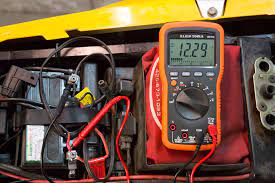Motorcycle batteries are essential for powering the electrical systems of these two-wheeled machines. Understanding the voltage of a motorcycle battery is crucial to ensure optimal performance and longevity.
In this article, we will delve into the world of motorcycle batteries, exploring their voltage range, factors that affect voltage levels, signs of low voltage, and steps to maintain optimal voltage.
Whether you’re a seasoned rider or new to motorcycles, knowing how many volts your motorcycle battery needs is key to keeping your ride running smoothly.
Key Takeaways of How Many Volt Is A Motorcycle Battery?
- The standard voltage for most motorcycles is 12 volts.
- Using a higher voltage battery can damage the electrical system.
- Troubleshoot low voltage with checks for loose connections, corrosion, or a faulty charging system.
- Using the correct charger for the specific battery type is important.
Understanding Motorcycle Batteries
A motorcycle battery typically has a voltage of 12 volts. Measuring the voltage accurately is essential to ensure the battery’s health and performance. To measure the voltage, you can use a multimeter or voltmeter, which provides an accurate reading of the battery’s current state.
It is important to note that temperature can have an impact on the battery voltage. In cold weather, for example, the battery’s voltage may drop temporarily due to increased internal resistance. On the other hand, high temperatures can cause the voltage to rise slightly.
Understanding these variations helps determine whether your motorcycle battery requires charging or replacement.
Now that we have covered measuring voltage accurately and its relationship with temperature, let’s delve into the basics of voltage in motorcycle batteries without further ado.
The Basics of Voltage in Motorcycle Batteries
Voltage in motorcycle batteries can vary depending on the model and type of battery used. Measuring voltage accurately is crucial for troubleshooting voltage issues. To understand the basics of voltage, it is helpful to consider a few key points. First, it’s important to note that a battery’s voltage represents its electrical potential difference, or the force with which electrons flow through a circuit. Second, different types of motorcycle batteries have different voltages. For example, most lead-acid batteries typically have a voltage range between 12 and 13 volts when fully charged. On the other hand, lithium-ion batteries usually have higher voltages ranging from 14 to 16 volts when fully charged. Understanding these variations in voltage is essential for properly maintaining and diagnosing any potential issues with motorcycle batteries.
Moving forward into the subsequent section about the common voltage range for motorcycle batteries…
Common Voltage Range for Motorcycle Batteries
To determine if your motorcycle battery is operating within the right range, you should check the voltage regularly. The common voltage range for motorcycle batteries varies depending on the type of battery.
Here are some common voltage ranges for different motorcycle battery types:
- Conventional Lead-Acid Battery: Typically has a voltage range of 12.6 to 13.8 volts.
- Absorbed Glass Mat (AGM) Battery: Usually has a voltage range of 12.8 to 14.7 volts.
- Lithium-Ion Battery: Generally has a voltage range of 13.2 to 14.4 volts.
- Gel Cell Battery: Typically has a voltage range of 13.0 to 13.8 volts.
- Maintenance-Free Battery: Usually has a voltage range of 12.6 to 13.8 volts.
Keep in mind that these are general ranges and may vary slightly depending on the specific brand and model of your motorcycle battery.
Factors such as temperature, age, and usage can affect motorcycle battery voltage. If you notice that your battery voltage falls outside of the recommended range, it may be a sign that your battery needs further inspection to check its overall health.
Factors That Affect Motorcycle Battery Voltage
Factors such as temperature, age, and usage can impact the voltage of a motorcycle battery. These factors play a crucial role in determining the overall lifespan and performance of the battery.
Firstly, temperature affects battery voltage significantly. Extreme cold temperatures reduce the chemical reactions within the battery, leading to a decrease in voltage output. On the other hand, high temperatures can cause excessive evaporation and lead to fluid loss, resulting in reduced voltage levels.
Secondly, the age of the battery also influences its voltage output. Over time, internal components degrade, reducing its capacity to hold a charge and ultimately affecting its voltage.
Lastly, how frequently and how heavily a motorcycle is used affects battery life as well. Frequent short rides or extended periods of inactivity can both impact voltage levels.
Understanding these factors is essential for maintaining proper voltage levels in motorcycle batteries and ensuring optimal performance without compromising safety or reliability for riders.
Importance of Proper Voltage for Motorcycle Performance
Maintaining the correct voltage is crucial for optimal performance and reliability of a motorcycle. The importance of proper voltage for motorcycle safety cannot be overstated.
Insufficient voltage can result in weak ignition, causing the engine to misfire or fail to start altogether. On the other hand, excessive voltage can damage electrical components, leading to costly repairs.
Furthermore, the impact of voltage on motorcycle battery lifespan is significant. A battery that consistently operates at a higher or lower voltage than recommended will experience premature wear and reduced overall lifespan.
To ensure safety and prolong the life of your motorcycle battery, it is essential to regularly measure its voltage using a multimeter or voltmeter. This measurement provides valuable information about the state of charge and health of your battery, allowing you to take necessary actions before any major issues arise in the future.
How to Measure the Voltage of a Motorcycle Battery
To ensure optimal performance, it is crucial for motorcyclists to measure the voltage of their battery regularly. By doing so, they can identify any potential issues and take necessary actions.
There are several techniques available to accurately measure the voltage of a motorcycle battery. One common method involves using a digital multimeter, which provides an accurate reading of the battery’s voltage level. Additionally, troubleshooting tips can be helpful in diagnosing any problems related to low voltage, such as checking for loose connections or corrosion on the battery terminals.
Furthermore, ensuring that the motorcycle’s charging system is functioning properly is essential in maintaining a healthy battery voltage. By following these measuring techniques and troubleshooting tips, riders can effectively monitor their battery’s health and address any issues promptly.
Transitioning into the subsequent section about ‘signs of a low voltage motorcycle battery’, it is important to be aware of certain indicators that may suggest a need for immediate attention.
Signs of a Low Voltage Motorcycle Battery
If your motorcycle’s battery voltage is low, you may notice signs such as difficulty starting the engine or dimming headlights. These indicators are important to pay attention to because they can help you identify whether your motorcycle’s battery needs attention or replacement.
There are several causes of motorcycle battery voltage drop, including a weak alternator, loose connections, or excessive power draw from accessories. Troubleshooting low voltage issues involves checking the battery terminals for corrosion and ensuring they are tightly connected. Additionally, testing the charging system with a multimeter can help determine if the alternator is functioning properly.
Regularly maintaining your motorcycle’s battery can prevent voltage drop issues in the future. By keeping it clean and free from corrosion, checking its charge regularly, and avoiding excessive accessory usage, you can maintain optimal voltage in your motorcycle battery.
Transition: To ensure that your motorcycle’s battery remains in good condition and maintains an optimal voltage level…
Steps to Maintain Optimal Voltage in Your Motorcycle Battery
One effective way to keep your motorcycle battery’s voltage at its best is by regularly checking and cleaning the terminals. This simple maintenance step ensures a good electrical connection and prevents corrosion buildup, which can hinder the battery’s performance. Additionally, following proper charging steps is crucial for maintaining optimal voltage in your motorcycle battery. It is important to use a compatible charger and avoid overcharging or undercharging the battery. Troubleshooting common voltage issues in motorcycle batteries involves inspecting for loose connections, testing the battery’s voltage with a multimeter, and considering factors like temperature and age of the battery. By taking these steps, you can ensure that your motorcycle battery operates at its full potential. Moving forward, choosing the right battery voltage for your motorcycle is essential in maximizing its performance and longevity.
Choosing the Right Battery Voltage for Your Motorcycle
Make sure you choose the correct voltage for your motorcycle’s battery to ensure optimal performance and longevity. Here are four important factors to consider when choosing the right battery voltage:
- Motorcycle Specifications: Check your motorcycle’s specifications or consult the owner’s manual to determine the recommended battery voltage for your specific model.
- Battery Brand: Choose a reputable battery brand that offers batteries with the correct voltage for your motorcycle. Research customer reviews and ratings to ensure you select a reliable brand known for its quality products.
- Impact of Temperature: Consider the climate in which you’ll be riding your motorcycle. Extreme temperatures can affect battery performance, so select a voltage that is suitable for both cold and hot weather conditions.
- Consultation: If you’re unsure about which battery voltage is best for your motorcycle, seek advice from a professional mechanic or experienced rider who can provide guidance based on their knowledge and expertise.
Choosing the right battery voltage is crucial for optimal performance and longevity of your motorcycle’s battery. Now let’s delve into some frequently asked questions about motorcycle battery voltage…
Frequently Asked Questions about Motorcycle Battery Voltage
Are you curious to learn more about motorcycle battery voltage? When it comes to motorcycle battery charging, understanding the proper voltage is crucial. Here are some frequently asked questions about motorcycle battery voltage:
| Question | Answer |
|---|---|
| What is the standard voltage for a motorcycle battery? | The standard voltage for most motorcycles is 12 volts. |
| Can I use a higher voltage battery on my motorcycle? | It is not recommended to use a higher voltage battery as it can damage the electrical system of your bike. Stick with the recommended 12-volt option. |
| How do I troubleshoot low battery voltage? | If you’re experiencing low battery voltage, check for loose connections, corrosion, or a faulty charging system. It’s also important to ensure that you’re using the correct charger for your specific battery type. |
Understanding these basics about motorcycle battery voltages will help ensure that your bike stays powered up and ready to ride.
Frequently Asked Questions
Can I use a car battery in my motorcycle?
Using a car battery in a motorcycle may cause compatibility issues. Car batteries typically have higher voltage and are larger, which can lead to improper fitment and potential damage to the motorcycle’s electrical system.
What are the consequences of using a motorcycle battery with too high of a voltage?
Using a motorcycle battery with too high of a voltage can have serious consequences. Overcharging can lead to battery damage, shortened lifespan, and even explosions. It’s crucial to use the correct voltage to ensure safety and optimal performance.
Is it possible to overcharge a motorcycle battery and damage it?
Overcharging a motorcycle battery can damage it and shorten its lifespan. It is important to use a charger with the correct voltage and charging rate to avoid overcharging risks.
Can extreme temperatures affect the voltage of a motorcycle battery?
Extreme temperatures can indeed affect the voltage of a motorcycle battery. High temperatures can cause the battery to lose its charge faster, while low temperatures can reduce its overall capacity. To prevent overcharging, it’s important to use a smart charger that automatically shuts off when the battery is fully charged.
How long does a motorcycle battery typically last before it needs to be replaced?
To properly maintain a motorcycle battery and extend its lifespan, follow these tips: regularly check the battery’s voltage, keep it clean and free from corrosion, store it in a cool place when not in use, and use a battery tender when necessary.
Conclusion
In conclusion, understanding the voltage of a motorcycle battery is crucial for maintaining optimal performance. By ensuring that your battery has the right voltage and taking steps to maintain it, you can avoid issues such as starting problems and reduced power output.
Remember, knowledge is power when it comes to motorcycle batteries, so stay informed and keep your ride running smoothly. As they say, ‘knowledge is horsepower,’ and with the right information about voltage, you’ll be ready to hit the road with confidence.







